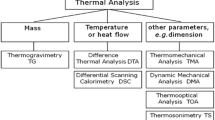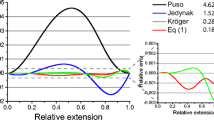Summary
Muscle fibres in the rigor state and free of nucleotide contract if heated above their physiological working temperature. Kinetic studies on the mechanism of this process, termed rigor contraction, indicate that it has a number of features in common with the contraction of maximally Ca2+ activated fibres. De novo tension generation appears to be associated with a single, tension sensitive, endothermic step in both systems. Rigor contraction differs in that steps associated with crossbridge attachment and detachment are absent. We investigated structural changes associated with rigor contraction using X-ray diffraction. Overall changes in the low angle X-ray diffraction pattern were surveyed using a two-dimensional image plate. Reversible changes in the diffraction pattern included a 28% decrease in intensity of the 14.5 nm meridional reflection, a 12% increase in intensity of 5.9 nm actin layer-line and a somewhat variable 34% increase in intensity of 5.1 nm actin layer-line in laser temperature-jump experiments. When fibres were heated with a temperature ramp, we found that a 70% decrease in intensity of the myosin-related meridional reflection at (14.5 nm)-1 correlated with tension generation. A similar decrease in intensity of the 14.5 nm reflection is seen during tension recovery following a step change in the length of maximally Ca2+ activated fibres. Signals both from actin and actin-bound myosin heads contribute to the 5.1 and 5.9 nm actin layer-lines. Our observed changes in intensity are interpreted as contraction-associated changes in crossbridge shape and/or position on actin.
Similar content being viewed by others
References
BARRINGTON-LEIGHJ., GOODYR. S., HOFMANNW., HOLMESK., MANNHERZH. G., ROSENBAUMG. & TREGEARR. T. (1977) The interpretation of X-ray diffraction from glycerinated flight muscle fiber bundles: new theoretical and experimental approaches. In Insect Flight Muscle (edited by TREGEARR. T.) pp. 137–47. Amsterdam: Elsevier/North Holland.
BARTELSE. M. & ELLIOTTG. F. (1983) Donnan potentials in glycerinated rabbit skeletal muscle: the effects of nucleotides and of pyrophosphate. J. Physiol. 343, 32–3P.
BARTELSE. M. & ELLIOTTG. F. (1985) Donnan potentials from the A- and I-bands of glycerinated and chemically skinned muscles, relaxed and in rigor. Biophys. J. 48, 61–76.
BARTELSE. M., COOKEP. H., ELLIOTTG. F. & HUGHESR. A. (1993) The myosin molecule —charge response to nucleotide binding. Biochim. Biophys. Acta 1157, 63–73.
BORDASJ., DIAKUNG. P., DIAZF. G., HARRIESJ. E., LEWISR. A., LOWYJ., MANTG. R., MARTIN-FERNANDEZM. L. & TOWNS-ANDREWSE. (1993) 2-dimensional time-resolved X-ray diffraction studies of live isometrically contracting frog sartorius muscle. J. Muscle Res. Cell Motil. 14, 311–24.
BOULINC., KEMPFR., KOCHM. H. J. & MCLAUGHLINS.M. (1986) Data appraisal, evaluation and display for synchroton radiation experiments: hardware and software. Nucl. Instrum. Methods A249, 399–407.
BOULINC., KEMPFR., GABRIELA. & KOCHM. H. J. (1988) Data acquisition systems for linear and area X-ray detector using delay line readout. Nucl. Instrum. Methods A269, 312–20.
BRENNERB. & YUL. C. (1993) Structural changes in the actomyosin cross-bridges associated with force generation. Proc. Natl Acad. Sci. USA 90, 5252–6.
CECCHIG., BAGNIM. A., GRIFFITHSP. J., ASHLEYC. C. & MAEDAY. (1991) Detection of radial crossbridge force by lattice spacing changes in intact single muscle fibers. Science 250, 1409–11.
CECCHIG., GRIFFITHSP. J., BAGNIM. A., ASHLEYC. C. & MAEDAY. (1991) Time-resolved changes in equatorial X-ray diffraction and stiffness during rise of tetanic tension in intact length-clamped single muscle fibers. Biophys. J. 59, 1273–83.
DAVISJ. S. & HARRINGTONW. F. (1987) Force generation by muscle fibers in rigor: a laser temperature-jump study. Proc. Natl Acad. Sci. USA 84, 975–9.
DAVISJ. S. & HARRINGTONW. F. (1993a) A single orderdisorder transition generates tension during the Huxley-Simmons phase-2 in muscle. Biophys. J. 65, 1886–98.
DAVISJ. S. & HARRINGTONW. F. (1993b) Kinetic and physical characterization of force generation in muscle: a laser temperature-jump and length-jump study on activated and contracting rigor fibers. Adv. Exp. Med. Biol. 332, 513–24.
DAVIS, J. S. & HARRINGTON, W. F. (1993c) Contraction of activated and heated rigor fibers: a laser temperature-jump and length-step study. Biophys. J. 64, A345.
DAVISJ. S. & RODGERSM. E. (1995a) Force generation and temperature-jump and length-jump tension transients in muscle fibers. Biophys. J. 68, 2032–40.
DAVISJ. S. & RODGERSM. E. (1995b) Indirect coupling of phosphate release to de novo tension generation during muscle contraction. Proc. Natl Acad. Sci. USA 92, 10482–6.
DAVIS, J. S. & RODGERS, M. E. (1996) The two myosin heads function sequentially in non-tension and tension generating modes during isometric contraction. Biophys. J. 70, A126.
FINERJ. T., SIMMONSR. M. & SPUDICHJ. A. (1994) Single myosin molecule mechanics: piconewton forces and nanometre steps. Nature 368, 113–19.
GABRIELA. (1977) Position sensitive X-ray detectors. Rev. Sci. Instrum. 48, 1303–5.
HARFORDJ. J. & SQUIREJ. M. (1992) Evidence for structurally different attached states of myosin cross-bridges on actin during contraction of fish muscle. Biophys. J. 63, 387–96.
HARRINGTONW. F. (1971) A mechanochemical mechanism for muscle contraction. Proc. Natl Acad. Sci. USA 68, 685–9.
HARRINGTONW. F. (1979) On the origin of the contractile force in skeletal muscle. Proc. Natl Acad. Sci. USA 76, 5066–70.
HARRINGTONW. F., RODGERSM. E. & DAVISJ. S. (1990) Functional aspects of the myosin rod in contraction. In Molecular Mechanisms in Muscle Contraction (edited by SQUIREJ. M.) pp. 241–63. London: Macmillan.
HASELGROVEJ. C. (1975) X-ray evidence for conformational changes in the myosin filaments of vertebrate striated muscle. J. Mol. Biol. 92, 113–43.
HENDRIXJ., KOCHM. H. J. & BORDASJ. (1979) A double focusing X-ray camera for use with synchrotron radiation. Appl. Cryst. 12, 467–72.
HOLMESK. C., TREGEARR. T. & BARRINGTON-LEIGHJ. (1980) Interpretation of the low-angle X-ray diffraction from insect flight muscle in rigor. Proc. R. Soc. Lond. Ser. B 207, 13–33.
HUXLEYH. E. (1968) Structural difference between resting and rigor muscle; evidence from intensity changes in the low angle equatorial X-ray diagram. J. Mol. Biol. 37, 507–20.
HUXLEYH. E. (1969) The mechanism of muscular contraction. Science 164, 1356–66.
HUXLEYH. E. & BROWNW. (1967) The low-angle X-ray diagram of vertebrate striated muscle and its behaviour during contraction and rigor. J. Mol. Biol: 30, 383–434.
HUXLEYH. E. & FARUQIA. R. (1983) Time-resolved X-ray diffraction studies on vertebrate striated muscle. Ann. Rev. Biophys. Bioeng. 12, 381–417.
HUXLEYH. E. & KRESSM. (1985) Crossbridge behaviour during muscle contraction. J. Muscle Res. Cell Motil. 6, 153–61.
HUXLEYA. F. & SIMMONSR. M. (1971) Proposed mechanism of force generation in striated muscle. Nature 233, 533–8.
HUXLEYH. E., SIMMONSR. M., FARUQIA. R., KRESSM., BORDASJ. & KOCHM. H. J. (1983) Changes in the X-ray reflections from contracting muscle during rapid mechanical transients and their structural implications. J. Mol. Biol. 169, 469–506.
IRVINGM., LOMBARDIV., PIAZZESIG. & FERENCZIM. A. (1992) Myosin head movements are synchronous with the elementary force-generating process in muscle. Nature 357, 156–8.
KABSCHW., MANNHERTZH. G., SUCKD., PAIE. F. & HOLMESK. C. (1990) Atomic structure of the actin: DNase I complex. Nature 347, 37–44.
KRESSM., HUXLEYH. E., FARUQIA. R. & HENDRIXJ. (1986) Structural changes during activation of frog muscle studied by time-resolved X-ray diffraction. J. Mol. Biol. 188, 325–42.
KUBALEKE. W., UYEDAT. Q. & SPUDICHJ. A. (1992) A Dictyostelium myosin II lacking a proximal 58-kDa portion of the tail is functional in vitro and in vivo. Mol. Biol. Cell 3, 1455–62.
MATSUBARAI., GOLDMANY. E. & SIMMONSR. M. (1984a) Changes in the lateral filament spacing of skinned muscle fibres when cross-bridges attach. J. Mol. Biol. 173, 15–33.
MATSUBARAI., YAGIN., MIURAH., OZEKIM. & IZUMIT. (1984b) Intensification of the 5.9-nm actin layer-line in contracting muscle. Nature 312, 471–3.
PODOLSKYR. J., NAYLORG. R. & ARATAT. (1982) Crossbridge properties in the rigor state. Soc. Gen. Physiol. Ser. 37, 79–89.
POOLE, K. J. V. & RAPP, G. (1991) X-ray diffraction measurements on the effect of rapid length changes in rigor cross-bridges in skinned rabbit psoas fibres. Biophys. J. 59, 575a.
POOLEK. J., RAPPG., MAEDAY. & GOODYR. S. (1988) The time course of changes in the equatorial diffraction patterns from different muscle types on photolysis of caged-ATP. Adv. Exp. Med. Biol. 226, 391–404.
RAPPG. & GOODYR. S. (1991) Light as a trigger for timeresolved structural experiments on muscle, lipids, p21 and bacteriorhodopsin. J. Appl. Cryst. 24, 857–65.
RAPPG., KOCHM. H. J., HÖHNEU., LVOVY. & MÖHWALDH. (1995) Time-resolved X-ray diffraction study of the temperature dependence of the structure of magnesium stearate multilayers. Langmuir 11, 2348–51.
RAYMENTI., RYPNIEWSKIW. R., SCHMIDT-BÄSEK., SMITHR., TOMCHICKD. R., BENNINGM. M., WINKELMANND. A., WESENBERGG. & HOLDENH. M. (1993a) 3-dimensional structure of myosin subfragment-1—a molecular motor. Science 261, 50–8.
RAYMENTI., HOLDENH. M., WHITTAKERM., YOHNC. B., LORENZM., HOLMESK. C. & MILLIGANR. A. (1993b) Structure of the actin-myosin complex and its implications for muscle contraction. Science 261, 58–65.
ROMEE. (1973) Structural studies by X-ray diffraction of striated muscle permeated with certain ions and proteins. Cold Spring Harbor Symp. Quant. Biol. 37, 331–9.
SQUIREJ. M. (1981) The Structural Basis of Muscular Contraction. New York: Plenum.
TOYOSHIMAY. Y., KRONS. J. & SPUDICHJ. A. (1990) The myosin step size: measurement of the unit displacement per ATP hydrolyzed in an in vitro assay. Proc. Natl Acad. Sci. USA 87, 7130–4.
VIBERTP. J., HASELGROVEJ. C., LOWYJ. & POULSENF. R. (1972) Structural changes in actin-containing filaments of muscle. J. Mol. Biol. 71, 757–67.
WAKABAYASHIK., TANAKAH., SAITOH., MORIWAKIN., UENOY. & AMEMIYAY. (1991) Dynamic X-ray diffraction of skeletal muscle contraction: structural change of actin filaments. Adv. Biophys. 27, 3–13.
Author information
Authors and Affiliations
Rights and permissions
About this article
Cite this article
Rapp, G.J., Davis, J.S. X-ray diffraction studies on thermally induced tension generation in rigor muscle. J Muscle Res Cell Motil 17, 617–629 (1996). https://doi.org/10.1007/BF00154056
Received:
Revised:
Accepted:
Issue Date:
DOI: https://doi.org/10.1007/BF00154056




